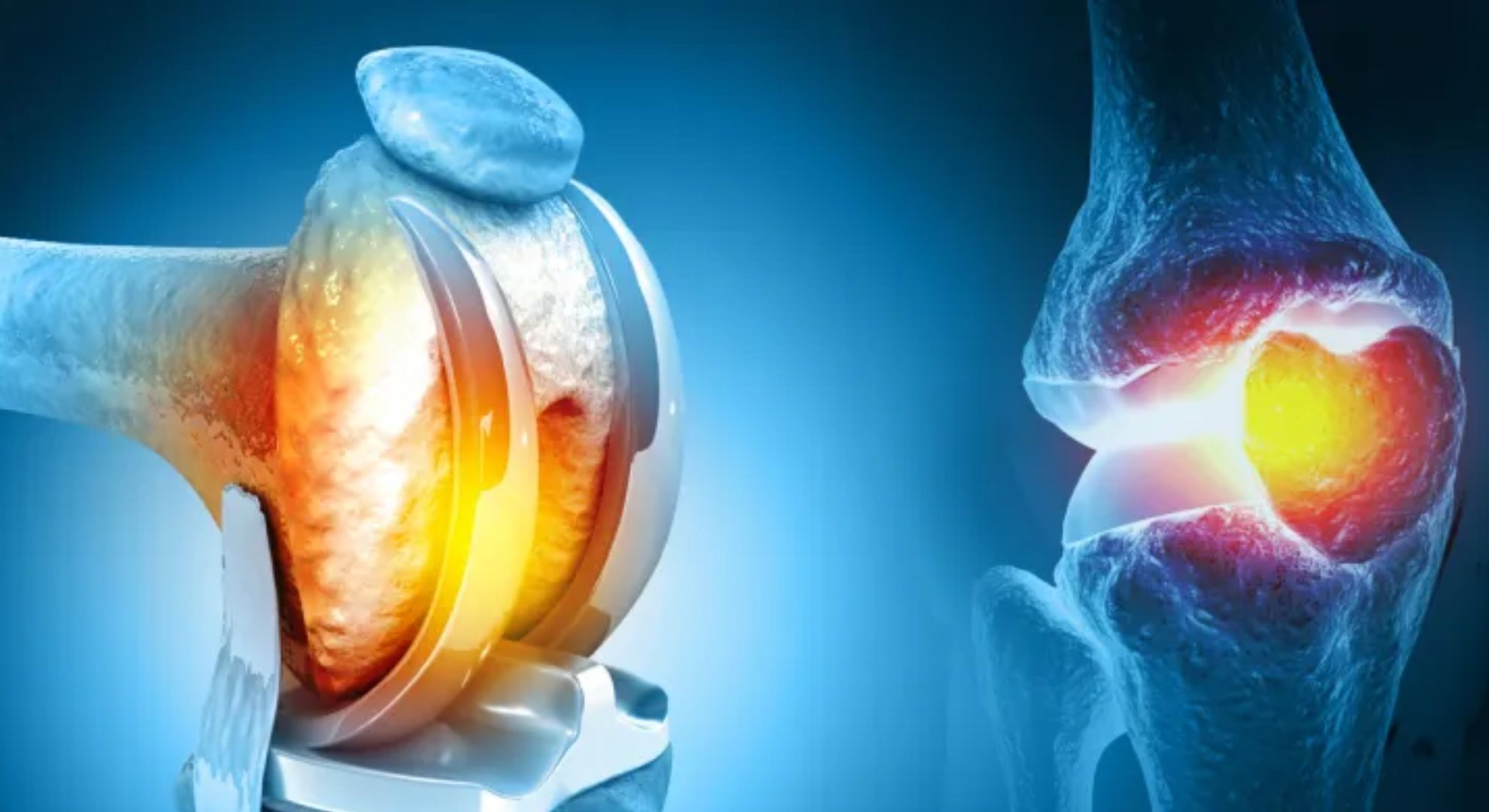Knee replacement surgery reduces pain and restores function in people with advanced arthritis. The surgery has been described as one of the most successful orthopedic procedures. However, this idea of success is often based on technical parameters, implant survival, or procedural outcomes. Decades of advancement in surgical technique and prosthesis technology have improved recovery outcomes, with fewer complications, and longer implant survival, but people still report dissatisfaction after knee replacement surgery due to the ongoing pain. Pain after surgery is normal but understanding the cause of pain is crucial for recovery.
What is Knee Replacement Surgery?
Knee replacement surgery removes damaged parts of your knee. The doctor then replaces the damaged parts with artificial ones. This helps reduce pain and improve movement. People often need knee replacement surgery due to arthritis or serious injuries that cause pain and limit their activity.
There are two main types: total and partial. Total replacement surgery replaces the entire knee while partial replacement surgery replaces only part of the knee.
The Nature of Postoperative Pain
Surgical pain is expected right after the surgery. This pain usually comes from the surgery itself. Chronic pain is different. It can last longer and may not be related to surgery. Immediately after surgery, pain is common which usually peaks in the first few days. Over the next few weeks, pain should start to lessen. However, some people may still feel discomfort for months.
Managing pain is crucial for recovery. If pain is too intense, it can restrict movement and healing. Good pain management helps patients get back to their daily activities faster.
What Factors Contribute to Extreme Pain After Knee Replacement Surgery?
After knee replacement surgery, patients often experience pain for various reasons. Understanding these factors can help in managing discomfort and improving recovery. Some common contributors to pain after knee replacement surgery are:
Knee Stiffness (Arthrofibrosis)
Knee stiffness occurs when too much collagen forms in the joint, leading to pain and limited movement. About 3-10% of knee replacement patients develop this condition, which can make activities like jumping very painful. The process can affect other organs too. After knee replacement, certain receptors in the knee area can trigger inflammation, leading to pain and potential joint damage over time. Many patients may also develop arthritis, which adds to their discomfort.
Instability
Some patients also report feeling unstable six months after surgery. Those who feel unstable often experience more pain and limitations in their daily activities. Flexion instability, where the knee can’t bend properly, can be caused by ligament injuries or issues with the knee implant. Factors like improper ligament release during surgery can also contribute to this problem. If the knee isn’t stable, it can lead to further pain and complications in the future.
Misaligned Parts (Component Malpositioning)
During knee replacement surgery, the proper positioning of the parts (femoral and tibial components) is very important. If they are misaligned, it can lead to pain and instability. Poor positioning can increase pressure in the knee and lead to wear over time. Rotating the implant incorrectly causes pain in the front of the knee, while proper alignment can reduce discomfort. Misalignment affects how the knee moves, leading to worse outcomes after surgery.
Aseptic Loosening
Aseptic loosening occurs when the knee implant becomes loose without infection, affecting some patients many years after surgery. This can happen due to instability, poor alignment, or wear and tear of the materials. Tiny particles from the implant can trigger an immune response, leading to bone loss around the implant. Over time, this can cause pain, especially when putting weight on the knee. Early signs of loosening can be seen on X-rays, highlighting areas around the implant.
Kneecap Misalignment (Maltracking)
Kneecap misalignment happens when the kneecap doesn’t move smoothly in its groove during movement, causing pain. This issue can arise from surgical methods, the implant used, or pre-existing conditions in patients. Factors like muscle weakness can worsen this. If the kneecap is not aligned properly, it can lead to cartilage damage and arthritis over time. Proper positioning during surgery is vital to prevent this problem.
Overstuffing
Overstuffing occurs when the knee implant is thicker than the original bone. This imbalance can lead to increased pressure in the joint, potentially causing pain and stiffness. It’s a common issue, and understanding its effects is important to improve the quality of life of the patient.
Polyethylene Wear
Wear of the polyethylene surfaces in knee implants is a common cause of failure, which can also influence the knee implant cost. Over time, the surface can degrade, leading to the release of tiny particles that cause inflammation and pain. This wear tends to affect the inner part of the knee more. Factors like implant design, surgery technique, and patient activity all contribute to how quickly wear occurs. Monitoring wear can help identify problems before they become serious.
Infection
Infections can lead to significant pain after surgery. They trigger inflammation, releasing substances that cause discomfort. Common bacteria responsible for joint infections can activate pain pathways in the body. Certain risk factors, like obesity or previous joint problems, can increase the chances of infection. Keeping these risks in mind is crucial for patient care.
Other Possible Factors
Psychological issues like anxiety and depression can also affect pain levels after knee surgery. Damage to nerves during surgery can lead to painful sensations and limit movement. Some patients experience ongoing pain due to heightened sensitivity in their nervous system.
Understanding these factors is important for managing pain and improving patient satisfaction and recovery.
What are Some Common Pain Management Strategies Recommended After Knee Replacement Surgery?
Pain management starts with medications. There are different types available. Depending on your health, your doctor may recommend either opioids, NSAIDs (ibuprofen or naproxen), or acetaminophen.
Apart from medications, your doctor may also suggest regular sessions of physical therapy for recovery after knee replacement surgery. A physical therapist helps patients learn exercises to improve movement and strength. Gentle movement helps reduce stiffness and pain. It also prepares the knee for daily activities. Regular sessions can speed up recovery and help regain full function. The therapist may also provide guidance on safe ways to move and perform daily tasks.
Many patients may find relief using alternative therapies. Ice application on the knee can help reduce swelling and numb pain. Elevating the leg can improve blood flow and decrease discomfort. Other complementary methods, like acupuncture, may also provide pain relief.
These therapies can work alongside medications and physical therapy to enhance recovery.
Psychological Impact of Pain
After knee replacement surgery, many people feel pain. This pain can affect mental health. When people experience chronic pain, it can lead to feelings of anxiety or depression. This emotional distress can make the perception of pain worse. Understanding this connection is important. Addressing mental health can improve pain management and overall recovery.
Coping strategies are also essential for managing pain. Meditation, deep breathing, engaging in hobbies, or spending time with loved ones can help reduce stress, provide distractions, and improve mood. Support systems are also vital. Talking to family, and friends, or joining support groups can create a sense of community.
Overall, addressing mental health is key to recovery. Pain management isn’t just physical; it also involves emotional support. Taking care of both aspects can improve overall well-being after surgery.
To Conclude
In conclusion, while knee replacement surgery is designed to reduce pain and improve function, many patients still experience discomfort during recovery. Understanding the causes of this pain is essential for effective management. By combining medication, physical therapy, and alternative treatments, you may find relief and regain mobility. Additionally, recognizing the psychological impact of pain is also essential. Addressing both physical and emotional aspects can lead to a more successful recovery and greater overall satisfaction with the surgery.
The causes of pain will likely become more evident in upcoming years with technological advancements and a greater understanding of the origin of the pain. Till then, your doctor should be prepared to make customized changes according to your health needs as there is no ‘one size fits all’ solution. With the right strategies and support, patients can look forward to a brighter, more active future.
For more insightful articles related to this topic, feel free to visit- ( Click Here )









